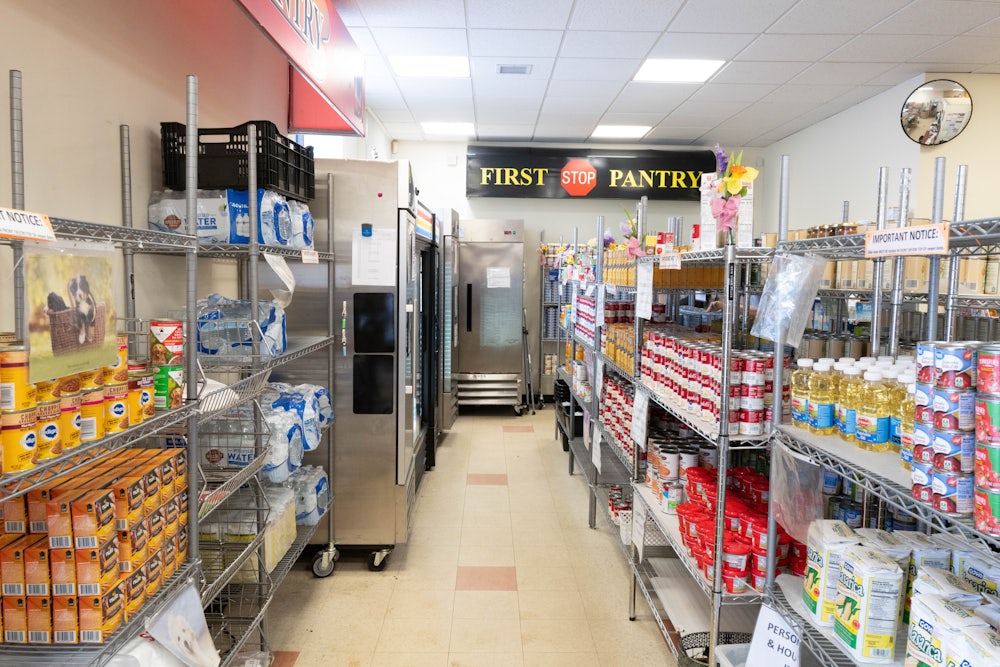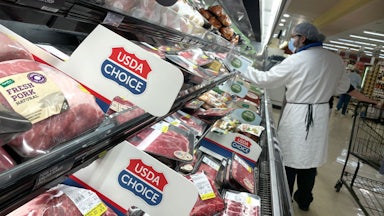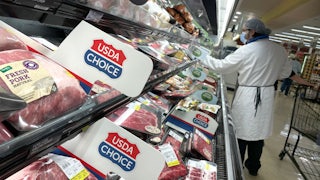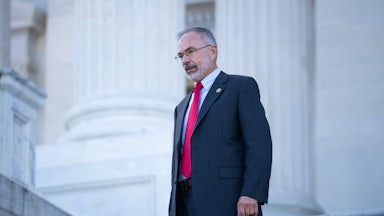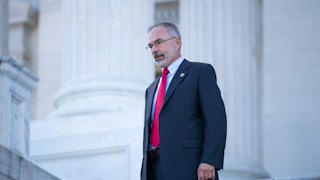The newly passed Republican bill slashing government spending and expanding tax breaks primarily for the wealthy has left the food banks that serve vulnerable populations all across the nation reeling, with leaders warning that cuts to food assistance programs and other benefits could force millions of Americans to seek help from charitable organizations lacking the infrastructure to pick up the slack.
The law dramatically slashes the Supplemental Nutrition Assistance Program and Medicaid, with the nonpartisan Congressional Budget Office estimating that millions of people could see reductions or altogether lose their benefits. Sixty percent of SNAP recipients also participate in Medicaid, and 40 percent of Medicaid participants are enrolled in SNAP—an overlap that means millions of low-income families will be doubly affected by the cuts. The measure tightens work requirements for both Medicaid and SNAP, and pushes much of the cost of SNAP onto states—both administrative costs and benefit amounts—which could result in states opting to slash nutrition benefits on their own. Food banks—often the resource of last resort in the fight against hunger—will bear the brunt of these deep cuts.
“A misperception of the public is that when needs go up, we do more. We can only do more when resources go up. We can’t magically produce more food,” said Brian Greene, the president and CEO of the Houston Food Bank. Food banks coordinate with local food pantries and other hunger relief organizations to obtain, store, and distribute food.
Feeding America, an umbrella organization that includes 200 food banks and 60,000 charitable partners nationwide, distributed six billion meals in 2024. The organization estimates that the reductions in SNAP that could occur as a result of the law could eliminate six billion to nine billion meals. This will put pressure on food pantries to source and redistribute additional food, said Sarah Moberg, the interim CEO of Second Harvest Heartland, a Minnesota-based organization that partners with food pantries and hunger programs across the state and in western Wisconsin.
“Food shelves would have to have the capacity to welcome twice the volume of meals through their doors, and their shelves, and their refrigerators and coolers, and so it is a logistical challenge, and one that, quite frankly, we’re not designed for,” said Moberg. “We don’t have the infrastructure to keep up with the degree of billions of meals lost through SNAP.”
In times of economic hardship, struggling families often turn to charitable organizations to supplement any federal benefits they may also receive. The number of American households that reported visiting a food pantry more than doubled between 2001 and 2014, in large part due to the increase in food insecurity associated with the Great Recession. Amid the coronavirus pandemic in 2020, food banks reported a 55 percent increase in demand for assistance, according to a report by Feeding America. As food insecurity has remained high, so has the need for help, with Feeding America reporting that 50 million people received charitable food assistance in 2023. The end of pandemic-era programs to increase benefits—such as the SNAP emergency allotments—also placed a greater strain on food banks and pantries.
Similar to previous times of struggle, food banks are now bracing for cuts to SNAP to lead to increased reliance on charitable assistance. These concerns are exacerbated by cuts already implemented by the Trump administration, including the Agriculture Department freezing $1 billion in funding for food banks and schools to purchase food and suspending a program that helps community hunger relief organizations purchase from local producers. Without additional funding, hunger organizations are going to find it difficult to match the need, said Greene.
“People say, ‘Oh, well, there’s going to be more people you serve.’ Well, there are, but they’re each going to get less,” he said. “This is what we’ve been given; this is what we can do. And it’s heartbreaking when we just see suffering going on, but it doesn’t enable us to do more.”
Many congressional Republicans have fretted over how slashing benefits might affect their chances of maintaining their seats in the 2026 elections. That said, this concern did not prevent the vast majority of politically vulnerable GOP lawmakers from voting for the law. Some of the most controversial cuts to SNAP and Medicaid will not go into effect until 2028, two years after the midterms, meaning that lawmakers might be insulated from electoral backlash in the immediate term. The provisions forcing states to shoulder more of the costs of SNAP, as well as the changes to Medicaid, are set to be implemented in 2028.
Nonetheless, the consequences of these impending policy changes could be felt years before they actually go into effect. Cuts to Medicaid may result in rural hospital closures across the country; a community medical center in Nebraska already announced that it would close last week, citing uncertainty over funding due to the new law. State legislatures may also choose to preemptively address the looming cost shift of SNAP, particularly since most states have a constitutional requirement to balance their budget each year; so states may choose to reduce benefits or tighten eligibility in advance of 2028.
Meanwhile, the changes to SNAP work requirements have no specific delay. The legislation expanded existing work requirements to people between the ages of 55 and 64, and to parents with children above the age of 14. The Urban Institute has estimated that more than 22 million American families would be affected by the cumulative changes to SNAP, losing some or all of their benefits. The Center on Budget and Policy Priorities has also extrapolated from Congressional Budget Office data that more than two million people would lose their benefits under the work requirement provision.
The law also eliminated SNAP-Ed, a nutrition education program intended to help recipients make healthier food choices—even as the Trump administration has touted a “Make America Healthy Again” agenda. This has an immediate effect for organizations such as the Houston Food Bank, which Greene said has now lost funding for its dietitians, who provide nutrition education for clients.
“We’re trying to figure out what’s the main way to wind that down, but we just simply will not be able to offer that service,” Greene said.
In some ways, the impending strain on food banks is reminiscent of the height of the coronavirus pandemic. But in 2020 and 2021, Congress approved legislation that increased benefits for struggling families, rather than slashing them. Moberg also contrasted the sense of community solidarity that accompanied that era with the current political atmosphere.
“During the pandemic, we saw everyone show up at the table,” said Moberg. “Donors and volunteers and community organizations really were pulling together in that moment, and it’s yet to be seen whether or not that same community response shows up at all levels and from all corners.”
